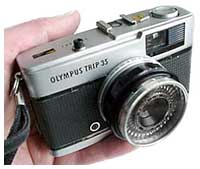If you take a look around you at the next theme park, parade, or
children's play you go to, you'll notice that the majority of
people seem to be using digital cameras. The concept of taking a
photo digitally and then transferring it to your computer,
manipulating it with something like iPhoto, and then printing it
for a fraction of the cost of processing regular film, has taken
off.
Everyone's got a digital camera, and every few months they seem
to shrink in size. When
Leica starts making them, you know that they've become
more than just toys.
It wasn't that long ago that you'd see people carrying 30+ year
old cameras over their shoulder with names like Argus, Yashica,
Kowa, and Konica. In the digital camera rush, people have set aside
their old 35mm cameras in favor of digital versions. As a result,
these older cameras frequently show up in thrift shops, garage
sales, and even in the trash, as was the case of a friend of mine
who found a nice Minolta in a dumpster.
Given that I'm a person who tends to like the quality,
durability, and aesthetics that old technology has to offer, while
I do have a digital camera, I prefer not to use it unless I need to
just take a picture of something or someone specifically for
uploading to the Internet. An eBay
auction is a perfect example of where I'd use my digital
camera.
 I've got a number of older 35mm film
cameras, although my favorite for convenience and size, is my
Olympus Trip
35, which has a cult following of its own. I seem to recall
reading somewhere that it was so popular that Olympus made the same
model, essentially unchanged, from 1966 until 1988. I bought mine
used a number of years ago and found that the pictures it takes are
absolutely fantastic.
I've got a number of older 35mm film
cameras, although my favorite for convenience and size, is my
Olympus Trip
35, which has a cult following of its own. I seem to recall
reading somewhere that it was so popular that Olympus made the same
model, essentially unchanged, from 1966 until 1988. I bought mine
used a number of years ago and found that the pictures it takes are
absolutely fantastic.
It's an automatic exposure camera, meaning that you don't need a
separate light meter, and it automatically sets the shutter speed
for you. The only thing you've got to do is focus it. With 200
speed film, it takes great pictures outdoors, and you can get some
good ones indoors with an electronic flash.
Of course, the advantage of a digital camera is being able to
simply plug in the camera to your Mac and pretty much transfer and
print the photos instantly. Having film processed still takes about
one hour and still costs about $6, give or take a couple bucks
depending on where you go to have it processed.
Taking pictures digitally is free, right?
Well, not exactly, as photo paper and ink run into quite a bit
of money. The color ink for my printer runs around $35, and photo
paper ranges from a few cents a sheet to a dollar or more a sheet
depending on the quality, brand, and where you buy it.
While still a bit cheaper - since you probably won't print out
all the photos you took - digital photography is not exactly free
after you buy the camera. I think that it's practical to have one
of each, a digital 'point and shoot' camera and a 35mm rangefinder
type camera, something like my 1963
Konica Auto S, which was, at least according to Konica,
the first auto-exposure 35mm camera.
What if you want pictures taken with your 35mm camera on your
computer? You've got a couple different options that I'll discuss
next week.

 I've got a number of older 35mm film
cameras, although my favorite for convenience and size, is my
I've got a number of older 35mm film
cameras, although my favorite for convenience and size, is my

